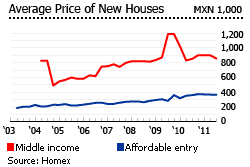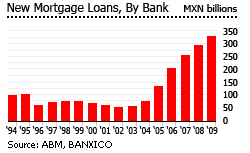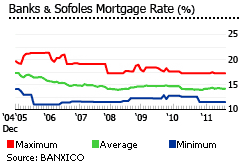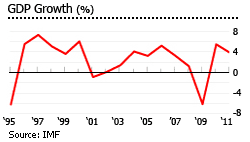Housing market recovery in Mexico

Mexico’s housing market is heading for recovery, despite US woes slowing economic growth throughout 2011. House prices in Mexico were up 4.48% during the year to Q3 2011 (1.07% in real terms), according to the Sociedad Hipotecaria Federal (SHF).
Similarly, average house prices in the Affordable-Entry segment of Homex, a major developer, rose 1.9% q-o-q to Q3 2011. Prices in the Middle income segment were up by 0.6%.

Stronger demand was evident in the 8% rise of mortgage loans granted during the year to April 2011. A rebound in economic activity helped. Mexico experienced 4.5% economic growth during the year to Q3 2011. The unemployment rate was down to 4.8%.
The impact of this economic growth on the banks’ loan portfolios is obvious; past-due loans both in Infonavit and in the banks were lower in Q2 2011. Bank loan defaults dropped to 3.4% in 2011, from 4.5% in 2009.

An expected surge of public investment in relation to the 2012 elections is likely to boost construction in late-2011 to 2012.
However, despite the economic rebound, both the manufacturing sector and domestic demand have been weakening recently, and the Mexican peso has continued to weaken against the US dollar.
The state drives house building

Over the past decade, Mexico’s homebuilding industry has been supported by a large need for homes, strong population growth, and aid from the state-supported funds INFONAVIT and FOVISSSTE. During the housing boom the ratio of self-built houses fell from 70% in 2000, to 30% of new houses in 2006. The growth of housing production, however, was interrupted during the financial crisis in 2008 to 2009.
In 2010, 375,769 new houses were available to be sold, according to La Asociación de Bancos de México (Mexican Banking Association). Around 70% of the units were intended for low-income and poor households or the ‘Social & Economic’ segment. 19% were for the ‘middle’ segment and 11% for ‘residential’ and ‘residential plus’ segments.
The government provides housing finance for low-income households mainly through INFONAVIT (Instituto del Fondo Nacional para la Vivienda de los Trabajadores or National Fund for Worker’s Housing Institute). The low-end segments are also served by Fovissste (Housing Fund for Public Sector Workers) and Sofoles (special-purpose non-bank financial institutions), sometimes co-financing with Infonavit. Sofoles also provides some mid-market loans.
As of Q2 2011:
- Infonavit provided 66% of mortgages
- Fovissste granted 11% of mortgages
- Sofoles provided 0.21% of mortgages
- Banks provided 20.03% of mortgages. Banks totally dominate high-end market segments.
- Other entities granted 2.54% of mortgages
Housing subsidies were granted by CONAVI (Comisión Nacional de la Vivienda or National Housing Commission) (68%), and FONHAPO (Low-Income Housing Fund) (32%).
Almost all houses sold by developers get financing from one of four major sources. The increase in the amount allocated for mortgage financing is directly correlated with the expansion of developer-built housing.
Mexico’s ‘housing deficit’ – i.e., inadequately-housed households – is estimated at around 8.9 million. Infonavit has increased its 2011 financing target to 480,000 new loans from 475,000 in 2010 in aid to the reduction of housing deficit.
Construction starts saw zero annual change in Q1 2011, but the construction industry is expected to accelerate in H2 2011 and in 2012 due to an anticipated rebound in public investment brought by the upcoming 2012 election.
Better lending conditions

From 2005 onwards, banks aggressively increased their mortgage portfolios. New mortgage loans rose from MXN75 billion (US$5.3 billion) in 2004, to MXN 135 billion (US$9.5 billion) in 2005, and MXN 328 billion (US$23.5 billion) in 2009.

Most mortgages issued by banks have interest rates fixed for the duration of the loan term.
The mortgage market was around 10% of GDP in 2010. Mortgage interest rates remain high - the average rate for banks and Sofoles was 14.25% in October 2011.
Since 2000, banks have made significant changes that have led to better access to loans, and more favourable lending conditions.
- Loan terms have been lengthened from 10 - 15 years in 2000, to the current level of up to 30 years.
- Mortgage processing fees have been reduced to an average of 3%, from 6%.
- Loan to value ratios have been raised to 80% – 90% from 65% or lower.
Effect of violence on the housing market
Although drug-related violence has been present in Mexico for the past three decades, the government was passively ignored the problem from the 1980s to early 2000s. This norm was broken when President Felipe Calderon took office in 2006 and implemented a militarized approach in dealing with drug cartels.
Calderon may have been partially successful, but around 40,000 people have been killed during his campaign against drug cartels. News about drug-related violence has particularly turned off potential American baby-boomer home-buyers.
However, a BBVA Research study has suggested that violence has only a limited effect on housing sales, because the violence is very regionally concentrated. Between 2008 and 2010, 46% of homicides were in five states only: Baja California, Durango, Sinaloa, Chihuahua and Guerrero, according to the SSP (Secretaría de Seguridad Publica or Public Security Ministry).
Plus, low income segments account for 80% of the housing market. The key issue for this segment is housing finance and housing supply, not violence, to which their communities are less vulnerable.
Constitutional ban on foreign land ownership
Foreigners might invest more, despite the violence, if there was no constitutional ban on the foreign ownership of land. Under the current system of fideicomiso, foreigners can only indirectly own real estate, by setting up bank trusts. Although this is relatively safe, it rests on the credibility of Mexico’s banking system and property registry administration, which unfortunately discourages many foreigners.
Economic slowdown

Mexico’s economy slowed this year (2011) because of the weakness of the US economy, with GDP expanding 4.5% during the year to Q3 2011. Mexico had 5.4% economic growth in 2010, after -6.2% growth in 2009. The recovery was possible largely through strong exports. Mexico’s economy is highly dependent on the US, and in 2010, 74% of Mexico’s exports went to the US. Remittances, Mexico’s second-largest source of foreign currency, amounted in 2010 to US$22.6 billion, or 3% of GDP, well down on the 2006 to 2008 average of US$25.6 billion.
In 2012, GDP is expected to grow only 3.3% (OECD forecast), again because of the weakness of the US economy.